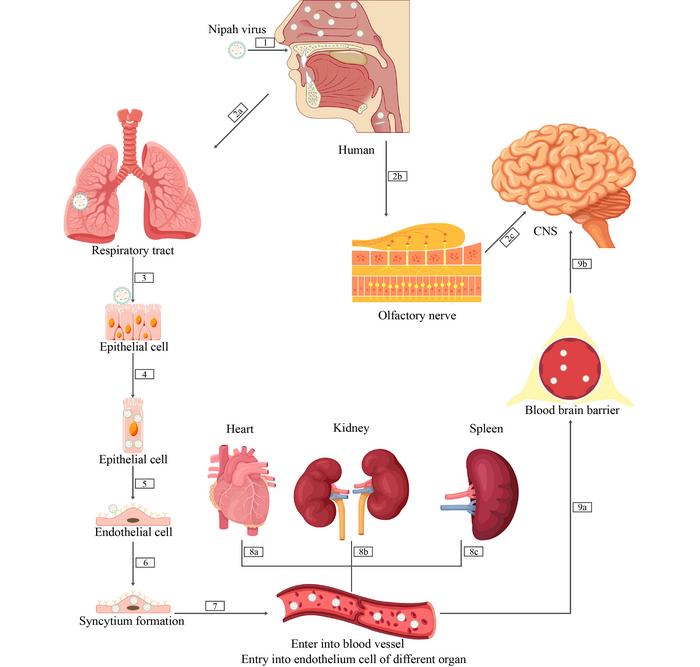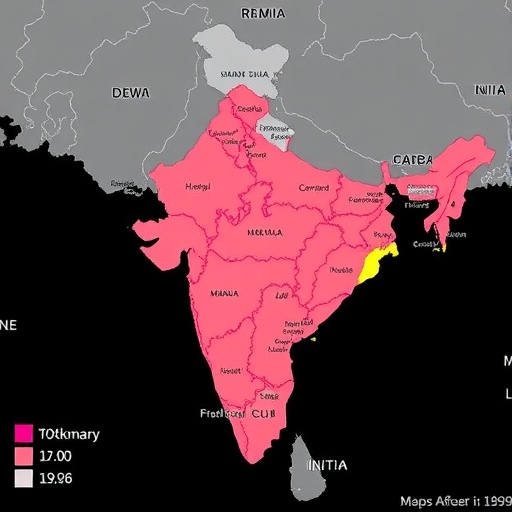
Nipah virus (NiV) is emerging as a significant public health concern, drawing attention from global health organizations due to its alarming mortality rates and potential for human-to-human transmission. Originating from South and Southeast Asia, the virus has triggered recurrent outbreaks, raising alarm among health officials and researchers alike. The genetic variations of NiV—primarily NiV-MY and NiV-BD—are linked to differences in their pathogenic behavior and the risk they pose to human populations. Initially identified in Malaysia in 1998, NiV has since demonstrated its capacity to infect humans through contact with infected animals, particularly species within the Pteropus bat genus, and via consumption of contaminated food products such as raw date palm sap.
The complexity of NiV epidemiology is underscored by its diverse host range, which extends beyond fruit bats, including domestic animals like pigs, serving as intermediaries that facilitate transmission to humans. Infections linked to NiV have predominantly occurred in countries such as Malaysia, India, Bangladesh, Singapore, and the Philippines, where the virus thrives in certain environmental and agricultural settings. The implications for human health are dire, as NiV infections often lead to severe clinical outcomes, showcasing a proclivity for acute respiratory distress, edema, and widespread tissue damage.
Pathogenesis of the Nipah virus involves an intricate process wherein the virus invades the respiratory tract before disseminating systemically. This process can result in inflammation of endothelial cells and subsequent vasculitis, affecting various organ systems. The high levels of mortality are attributed to the virus’s sophisticated evasion strategies against the host’s immune response. Studies reveal that NiV can prompt significant endothelial cell injury, impairing vascular integrity and leading to life-threatening complications.
Clinically, the manifestation of NiV in infected individuals ranges from mild, flu-like symptoms to severe neurological sequelae, which can include encephalitis. A worrying complication of NiV infections is the potential for relapsing symptoms or late-onset neurological issues, which can emerge long after the initial illness has resolved. Current clinical management predominantly focuses on supportive care, as no specific antiviral treatments have been definitively proven to be effective against NiV. Ribavirin, while historically utilized in some cases, shows inconsistent efficacy, leaving healthcare providers with limited options and placing greater emphasis on prevention and control.
The urgency to develop effective strategies against Nipah virus is palpable, as scientists race to create vaccines that could stave off future outbreaks. Various vaccine candidates are currently under investigation, including innovative approaches such as virus-like particle-based vaccines and those utilizing promising mRNA technology. However, as of now, no vaccine has received regulatory approval for use in humans, underscoring the critical gap in available preventative measures.
Effective public health strategies are essential for curbing NiV outbreaks. Mitigation efforts hinge on reducing the risk of exposure to the virus through robust surveillance systems, public education campaigns, and modifications in agricultural practices. Protective measures such as limiting the access of bats to date palm sap and implementing stringent hygiene protocols in pig farming are paramount in controlling the virus’s transmission dynamics. The need for a coordinated, multidisciplinary approach becomes ampler as health professionals, wildlife experts, and communities grapple with the reality of NiV outbreaks.
Collaboration across sectors is increasingly recognized as vital in addressing the multifaceted challenges posed by Nipah virus. Partnerships among governmental agencies, non-government organizations, and local communities are necessary to promote awareness and build resilience against potential outbreaks. Furthermore, research initiatives should prioritize developing novel therapeutics and preventive strategies while also addressing the socio-economic factors that influence outbreaks in vulnerable communities.
Awareness and education are crucial in preventing Nipah virus transmission, particularly among populations living in areas at risk. Public health campaigns should focus on educating communities about safe agricultural practices, the risks associated with fruit bat exposure, and the importance of hygiene when handling food products that could be contaminated. Only through concerted efforts to educate and engage communities can the cycle of transmission be effectively interrupted, protecting both human health and livelihoods.
The role of innovation in developing technologies for early detection of NiV is increasingly emphasized. Leveraging advances in genomic sequencing and bioinformatics can enhance understanding of NiV strain evolution, thereby informing better public health responses. Improved surveillance methods that incorporate modern technologies can enable rapid identification of outbreaks, facilitating timely interventions and potential containment strategies.
As research continues, the international community must remain vigilant regarding NiV’s emergence as a viral threat. Continued investment in public health infrastructure and research, combined with regional and global collaboration, lays the foundation for a more comprehensive response to this zoonotic virus. By prioritizing public health initiatives that integrate animal and human health perspectives, we can better prepare for potential future outbreaks of Nipah virus and other emerging infectious diseases.
Addressing the Nipah virus crisis requires a holistic understanding of its complexities, including ecological, epidemiological, and socio-economic dimensions. As the world navigates the challenges posed by NiV, a commitment to global collaboration, innovative research, and community engagement becomes essential. Preventative strategies, supportive care, and ongoing research are pivotal to safeguarding public health against the threats of emerging viruses like Nipah.
As we confront the realities of zoonotic diseases and their potential impact on global health, the lessons learned from Nipah virus outbreaks may serve as a catalyst for transformative change. A multi-faceted approach that prioritizes prevention, preparedness, and response will be essential in the face of future epidemiological challenges. Ultimately, the fight against Nipah virus is not just about protecting populations from the virus itself; it is about safeguarding the health of communities, preserving ecosystems, and fostering sustainable practices that can mitigate the risks of future outbreaks.
Subject of Research: Zoonotic Nipah Virus
Article Title: Nipah Virus: Epidemiology, Pathogenesis, Treatment, and Prevention
News Publication Date: 15-Dec-2024
Web References: DOI
References: N/A
Image Credits: Limei Wang, Denghui Lu, Maosen Yang, Shiqi Chai, Hong Du, Hong Jiang
Keywords: Nipah virus, zoonotic disease, public health, epidemiology, pathogenesis, vaccine development, transmission, prevention





